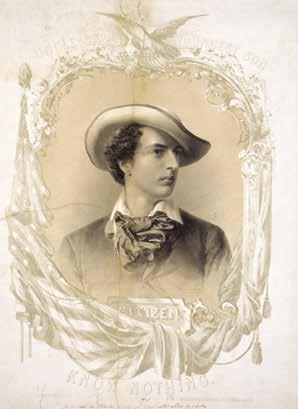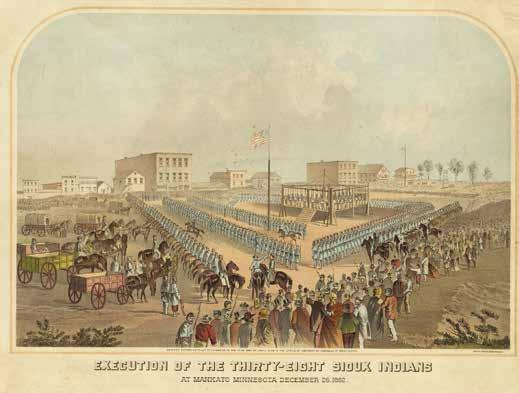
5 minute read
William Jayne: First Governor of Dakota Territory
By D. Jerome Tweton
In 1854, the political situation in Illinois was volatile. Abolitionists were outraged that Congress had given the people in the territories of Kansas and Nebraska the right to decide whether or not to allow slavery. The Know-Nothing party (officially Native American party) was demanding laws that would restrict immigration in a campaign that lauded “America for Americans.”
Advertisement
A committee of Springfield Know-Nothings wanted to nominate Abraham Lincoln for the Illinois legislature. Lincoln, who had already served in Congress, saw this as a backward political move and, hoping that the legislature might select him as United States senator, refused their overtures.
On September 3, William A. Jayne (1826-1916), Lincoln’s physician and Know-Nothing abolitionist, disregarded his wishes and placed an ad in the Illinois State Journal that announced Lincoln’s candidacy. An angry Mary Lincoln, looking out for her husband’s political career, rushed to the newspaper’s office and demanded the withdrawal of his name. Undaunted, Jayne rushed over to Lincoln’s house to convince him to stay in the race. As Jayne recalled many years later, Lincoln was “the saddest man I ever saw—the gloomiest.” Lincoln paced back and forth on the verge of tears, laying out the reasons he could not run. Jayne refused to take no for an answer, and finally Lincoln very reluctantly gave in.
Lincoln won the November election in a landslide. Sensing that the legislature might send him to Washington, Lincoln declined election. Abolitionists and Know-Nothings were furious. Dr. Jayne felt betrayed and now, in his words, everyone was “down on Lincoln—hated him.”
Jayne and Lincoln remained good friends. In 1860 Jayne, now the mayor of Springfield, won election to the Illinois state senate, and Lincoln captured the White House. Congress created Dakota Territory on March 2, 1861, and Lincoln rewarded his good friend and physician by appointing him the first governor of Dakota Territory.
As soon as the snows melted, Jayne headed west to oversee the organization of a governmental structure for the new territory.
Dakota Territory’s white population was small and scattered. The largest town was Yankton, with around 300 people. J.B.S. Todd, a cousin of Mrs. Lincoln, ran a trading company and controlled most businesses in town. Folks referred to Yankton as “Captain Todd’s town.” “His” town was a collection of sod and log houses; the Ash Hotel provided beds, food, and whiskey. Other settlements along the Missouri—Vermillion, Bon Homme, and Elk Point—claimed no more than a handful of residents. To the north, land speculators had lured a few dozen Minnesota people to the Sioux Falls area, and, to the far north, about 300 people, mostly Metis, lived around Pembina on the Canadian border.
Jayne arrived in Sioux City, Iowa, in late May, rented rooms for his wife, and set out by horse and buggy for Yankton. The new governor selected Yankton as the seat of government upon the suggestion of Mrs. Lincoln until the legislature could make an official selection. Until an adequate log house was built for the governor, he spent the first six weeks at the Ash Hotel where he had to share a bed with the attorney general.
He created three judicial districts and assigned a judge to each. He divided the settled areas into legislative districts, ordered an election for September 16, and scheduled the first session for the following March. The most important elected office—the territorial delegate to the Congress—was won by Todd. Although the delegate could not vote, the salary was good and life in Washington much superior to that in Yankton.
After the September election, the appointed and the elected officials left for their homes in the East, avoiding a bleak Dakota winter.
Governor Jayne and the other officials returned in March for the first legislative session. In his address to the lawmakers, he envisioned a great future for Dakota. “We have combined the pleasant, salubrious climate of southern Minnesota with the fertility of soil of central Illinois. I venture the prediction that the wheat granary of the continent will be found in the valley of the Red River.” That first session has been described as “rough-and-tumble” and “wild-and-woolly.” Capital selection was the main order of business and tested the patience of Governor Jayne. Bon Homme, Vermilllion, and Yankton fought it out. At one point Jayne had to provide military protection for the speaker of the house whom Todd had thrown through a closed window. Yankton won. Moses Armstrong of the surveyor general’s office described the process: “A little blood was shed, much whiskey drunk, a few eyes blackened, revolvers drawn, and some running done.”

Citizen Know Nothing, Uncle Sam’s Youngest Son, Sarony & Co. 1854.

President Abraham Lincoln and General George McClellan, Oct. 3, 1862, photo by Alexander Gardner.
If the politics of the 1862 legislative session were hectic, the September election of 1862 and the legislative session of 1863 surpassed hectic. The September election (1862) was the territory’s first general election. Voting irregularities were common: ballot box stuffing, minors and nonresidents voting. The election’s centerpiece was the contest for the representative to Congress. Governor Jayne decided to run against incumbent Todd. Voters had to choose between Mrs. Lincoln’s cousin and President Lincoln’s doctor. The canvassing board declared Jayne the winner by sixteen votes. But the ballots from Pembina, a Todd stronghold, arrived too late to be counted. Todd immediately filed a protest with Congress.
The 1863 legislative session was a bitter, divisive affair. Because of disputed election results in several legislative districts, two sets of lawmakers from each district arrived in Yankton—one group was loyal to Todd, the other to Jayne. The attorney general ruled in favor of the Todd legislators; Jayne, however, refused to accept that decision and worked with his own lawmakers. Dakota Territory had two legislatures. Finally a compromise was worked out and the session completed its work in relative peace. Jayne resigned in late March after the session to begin his life as territorial delegate. Lincoln, upon Jayne’s recommendation, appointed Newton Edmunds, the chief clerk in the surveyor general’s office, to the governorship. Jayne took his seat in Congress in January 1864. In May, however, the House Committee on Elections ruled that the Pembina votes, which were overwhelmingly for Todd, should be counted. Todd was declared the winner. Jayne went back to Springfield where he served as mayor for several terms.
D. Jerome “Jerry” Tweton is the host and moderator in the character of Dr. William Jayne, President Abraham Lincoln’s personal physician and the first governor of Dakota Territory.
Tweton has worked several years with the North Dakota Humanities Council as a consultant and contributing author to numerous publications. Tweton is also the Chester Fritz Distinguished Professor Emeritus of the University of North Dakota and the recipient of the State Historical Society of North Dakota’s Larry Remele Award. He has authored/edited fourteen books and holds a Ph.D. from the University of Oklahoma. Tweton originated a firstperson portrayal of Theodore Roosevelt in the late 1970s and early 1980s for the NDHC Chautauqua, and portrayed John Jacob Astor for four seasons in the last Great Plains Chautauqua Society program. Tweton and his wife Paula own and operate the historic Beiseker Mansion, a bed-and-breakfast establishment in Fessenden, ND.







